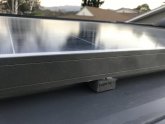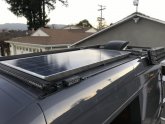Probably yes, overthinking/planning is definitely something I'm often guilty of. That said, its an area that should probably be explored more. We obsess over little electrical details, and theoretically possible modes of electrical failure, and overbuild/overdesign the electrical system, but spend almost no time considering mechanical modes of failure. Thinking about best practices and principles for mobile applications (especially off pavement) seems like a worthwhile endeavor.
Definitely, but that thing has $20k+ pivoting subframe that isolates the the camper from the frame allowing the frame to twist without transferring that torsion to the camper. This is outside of most of our budgets and design priorities. I was using the picture to show how much twisting occurs (its much easier to see with an isolated body). If I had that vehicle I wouldn't have a worry in the world about mounting solar on the camper, but with a sheet metal vehicle the body is meant to allow some twisting, probably not something to worry too much about, but still worth considering.
I may be missing your point or your joke, but I don't know where the $500 dollar figure is coming from (edit: connected the dots). The same principles would apply to a large solar budget or a small one, and are probably more applicable to a cheap vehicle than an expensive one like the one pictured (which could spend more on engineering and mitigation).
I think we pretty much agree (though it may not seem like I do) that torsional stress is probably not a factor in all but the most extreme cases. I just believe that (in some contexts like long range marine or overland travel) the same caution and focus on resilience/integrity that many here apply to electrical design should be applied to structural/mechanical design as well.
My main concern is the effect of vibration long term. In the past I've: had my battery box welds fail and the whole battery and box get lodged between the radiator fan and engine, lost a spare tire and rear tire carrier, had two window assemblies fail, had a battery cable connection fail, had numerous screws rattle loose, and had an interior floor crack and splinter (either due to torsion or vibration) all from washboard and/or moderate offroad travel, nothing extreme. Solar panels aren't the most expensive component by any means, but they are an investment, and they are meant to last 20+ years, I just want to be reasonably sure I won't be replacing them every few years because the panel I went with didn't match my application. But if it seems that nobody has had issues using the larger panels off pavement, I would be inclined to buck conventional wisdom and give em a try.





